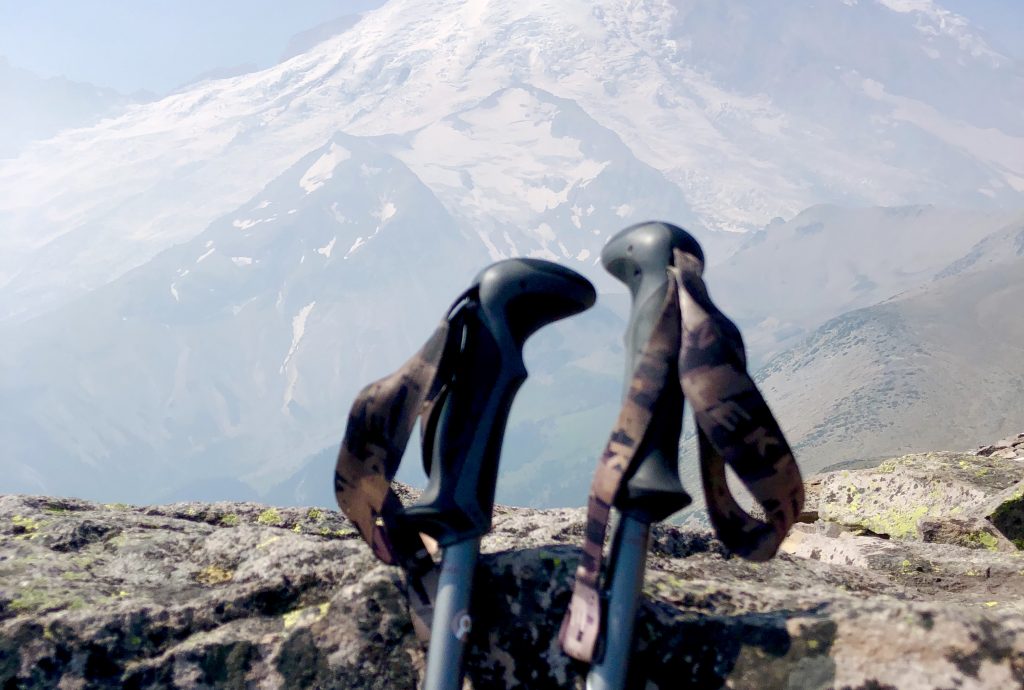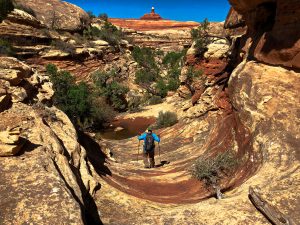
Part 4 of our “How to Go Hiking” series provides an overview of basic hiking clothing and equipment necessary for a comfortable and safe hiking adventure.

Chris & Mac
We outventure to help you outventure!
Support Grey Otter Outventures!
Please help us continue to bring you great content:
Pre-planning – Check! Water, hydration, food – Check! Navigation, first aid, emergency supplies – Check! Now it’s time to examine hiking clothing and equipment.
Hiking Clothing
Be comfortable! Stay away from cotton, particularly blue jeans. Performance wear is the only way to go. Cotton clothing gets wet from sweat and stays wet. Performance wear pulls moisture from the skin and dries quickly. We’ll save you the gory details, but moisture on the skin while hiking makes for an uncomfortable experience.
Performance underwear and shirts will ensure your comfort on the trail in all conditions (remember, in the cold you will also sweat if you are hiking a trail that is rigorous FOR YOU). As far as hiking pants or shorts, they should also be moisture wicking and allow you to move freely. Freedom of movement is particularly important in long pants and you can easily find hiking appropriate pants in 2-way or 4-way stretch. None of this needs to be top dollar clothing, discounted performance wear can be found in many stores and online or on sale. Unless you are a fashionista, it doesn’t matter how you look (the animals don’t care), it matters that you are comfortable.
Buy yourself good hiking socks. It can be hard to get these inexpensively, by sock standards, but your feet will thank you. We particularly like merino wool socks because they cool your feet in the warmer months and keep them warm in the cooler months. Check around and read some reviews about your socks. Your feet and their happiness are critical to your enjoyment, so treat them well.
Speaking of feet, let’s talk hiking shoes. There are a wide variety out there. We have all seen traditional, heavy hiking boots. For day hiking, you don’t need them. This might be different if you are going backpacking and carrying a heavy pack (we will discuss that in our “How to Backpack” section of this website). For day hiking there is a wide array of potential hiking shoes. An emerging trend is day hikers using trail running shoes for fast hiking. This may be great for the younger hikers, but folks over 40 generally need more support on our feet. A shoe specifically built for trail hiking, whether low, mid, or high cut is the way to go.
Hiking shoes do not have to be heavy, just supportive. In fact, we hike in high top shoes that have a ton of ankle support but weigh only 8.5 ounces per shoe. When picking out your hiking shoes, understand how your foot fits in a shoe (pronation) and your weaknesses. For example, if you need additional ankle support, use a higher top shoe or if you have bad knees, find a plush hiker. Your feet matter, so spend what you need to get the right hiking shoe. Obviously, if you are only going to hike once or twice a year, you don’t want to get too extravagant, but if you intend to become a serious hiker, invest in a quality shoe. Your feet will thank you with many miles of gorgeous trail.
Hats – get one! We personally do not like wearing hats, but we do. When you are on the trail, you may be faced with a good deal of sun exposure. Having a hat that shades your face and neck will keep you cooler and help you to avoid a sunburn.
As a final note, dress in layers when hiking and make sure you have appropriate clothing for changing weather conditions. Zip off pants legs come in very handy when you are in an area where the day starts cold and heats up, such as desert hiking, or where you have a rigorous hike to a high summit that will be chilly. In the same vein, don’t bring heavy jackets that you have to haul around. Lightweight layers create great thermal qualities and are easy to store when you don’t need them.
Hiking Equipment
First of all, unless you are simply going to do a couple of easy hikes a year, get a good hydration daypack. Standard backpacks are fine, but you will have to store water bottles, which are bulky. A hydration pack with a 3-liter reservoir will provide the water capacity you need for most hikes and distributes the water weight (2.2 pounds per liter!), making it easier to carry. Make sure the pack has adequate storage for what you carry, plus a little extra room for shedding clothes. Also make sure the pack is comfortable on your back and distributes weight evenly. After a few miles, a poor fitting pack will become a drag and may even cause you back pain. All our bodies are different, as are pack designs, so find the one that is right for you.
Trekking poles are awesome! We never used them until we started backpacking, because we did not understand the benefit. Now we use them on almost all our hikes. Especially for us older folks, trekking poles can make hiking all the more enjoyable. First, when used properly, they transfer as much 40% of your weight off your legs and hips and onto your upper body, allowing less leg and foot fatigue. They also keep your posture more upright, which is better for your back and will enable you to hike longer. Additionally, they are a great assist on the uphills and can be a knee saver on the downhills. Finally, they come in very handy for balance when crossing streams or hiking over rocks. We highly recommend anyone over 40 uses a pair of trekking poles when hiking!
Bottom Line
There is, of course, more that can be written about hiking clothing and equipment – companies are continually releasing helpful products – but above are the basics to get you going. In future articles we will take a deeper dive into these subjects, but you now have enough to get started. Happy hiking!!day
Gear We Use for Day Hiking
To see descriptions of the gear Chris & Mac use for day hiking, as well as links to manufacturers and retailers offering the gear for sale, please CLICK HERE.
SAFETY DISCLAIMER: The activities discussed in this website are outdoor activities and, as such, have inherent risks to which participants are exposed. It is not the intent of this website, nor is it possible due to the variability of weather, terrain, equipment, and experience, to detail all of those risks. The information contained in this site is informational, but not instructive nor exhaustive. It is the sole responsibility of the user to ensure he/she is in good health, fully prepared, and fully informed as to dangers before undertaking any of the activities discussed in this website and the user does so at his/her own risk. The user understands that by using this website he/she acknowledges and accepts all risks associated with use of information from this website and participation in any particular activity addressed herein. Please see “Terms of Use” for additional information.
Want to share this article with your friends? Click on the share button below:
Want more?
Get the latest outventure updates by following us on social media . . .


